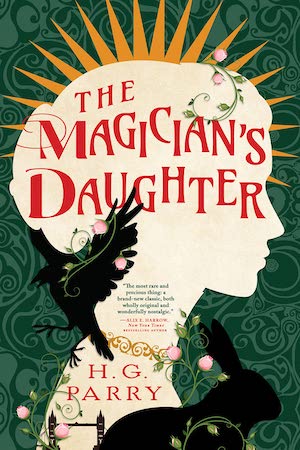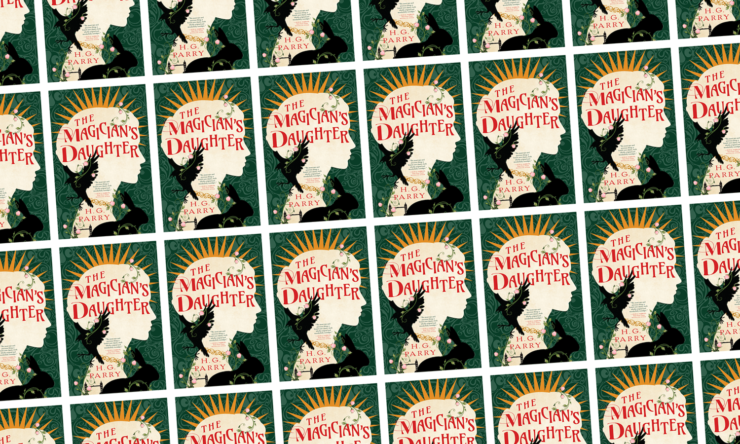It’s a rare book that is able to create a detailed, immersive world that also has richly developed and complicated characters. The Magician’s Daughter by H.G. Parry, I am happy to write, is one of those books.
The novel takes place in a 1912 version of our world and follows Biddy, a 16-or-so-year-old girl who has lived on the magical island off the coast of Ireland called Hy-Brasil her entire life. She was raised by a magician named Rowan and his rabbit familiar, Hutchincroft, and she has met no other person since she washed up on the island’s shores as a baby.
Biddy loves her home but yearns to see the world beyond, a place she knows is full of people and a place that no longer has magic. Even Hy-Brasil, an isle once rife with magical energy is waning—the interdimensional rifts where magic had seeped into the world started closing up 70 years ago, making magic a scarce resource. In 1912, Rowan and the other magicians out there believe all of those rifts are gone, making the remnants of magic that remain something that other mages seek to hoard and have control over. Those other magicians find Rowan, Hutch, and Biddy one day when creatures made up of dead bone and sinew come to the island and attack Biddy. It turns out, Rowan hasn’t been honest with her about the state of the world or about Biddy herself, and the three leave Hy-Brasil for the deary streets of Whitechapel on a mission to protect themselves. That mission soon goes awry, and Biddy finds out there’s even more that she’s been left in the dark about. Her journey goes on from there, where she seeks to save those she loves and possibly even save magic itself.
Buy the Book


The Magician’s Daughter
The plot, however, is arguably the least interesting thing about The Magician’s Daughter. That’s not to say the plot is bad, it’s perfectly fine, although those looking for a fast-paced, plot-driven story won’t find it here. There’s so much else to really love about the book, however, to make up for the relatively slow pace of the prose (if that’s even a negative to you to begin with).
Parry, as in her other works, weaves a rich version of the world the story takes place in. Her 1900s Britain isn’t without its sharp edges and dark sides, and the places that are meant to be damp, deary, and sad are exactly that. But then there’s Hy-Brasil, a beautiful, wild place that people from the mainland can only see once every seven years, and that you can’t help but want to visit as you read.
The magic that suffuses Hy-Brasil also suffuses the rest of the book, and as such, becomes a character in itself, with its own personality and wants. In this world, magic is an untethered thing, an essence that, when it was plentiful, helped people when they were at their worst. How magic helped, however, was a fickle thing, and may make things change in ways that the receiver might not accept or even, in certain circumstances, appreciate. That doesn’t stop Rowan, however, from expending what little magic is left when he wants to warm his cup of tea, and that doesn’t stop Biddy from always yearning to be able to touch magic directly like Rowan can.
This world and the chaotic fantastical power that once infused it is enough to get lost in on its own. But the heart of the story is the relationship between Rowan, Hutch, and Biddy. They are an unexpected family, but a family that couldn’t love each other more, although their relationships still have complexities and problems. The love the three have for each other is heart-aching, however, and I couldn’t help but want to give them all (but especially Hutch in bunny form) a hug.
It’s Biddy, however, who Parry eloquently describes as a “liminal person, trapped between a world she’d grown out of and another that wouldn’t let her in” that makes The Magician’s Daughter so refreshing and so compelling. She is the protagonist of the story, and while it seems at first that she’ll be a protagonist who follows the Chosen One path, Parry instead subverts that trope and gives us something different. Biddy isn’t special—she cannot wield magic and is, by one definition, one of the least special characters in the book. Despite being adopted by a mage and tied to magic in a way that few others are, her strength and ability to achieve remarkable things come from her unremarkable but solid convictions. She knows she is loved, and she also knows that she is, in many ways, alone. And while she finds herself thrown into a maelstrom of power grabs, undying vengeance, and mystical creatures beyond the confines of time, she is able to remain true to herself.
It’s through this harrowing journey that Biddy comes into her own. And you can’t help but feel for her and root for her—not just to save magic as well as her found family, but to figure out who she is and who she wants to become. If you’re looking for a book about found family, coming of age, and a tale with beautiful worldbuilding, then this is a book you should definitely pick up. And if you’re also looking for an adult book that reads like a fairy tale, where the plot is secondary to just wanting to spend time in this world and with these characters, then you should not only pick The Magician’s Daughter up but put it on the top of your TBR list.
The Magician’s Daughter is published by Redhook.
Vanessa Armstrong is a writer with bylines at The LA Times, SYFY WIRE, StarTrek.com and other publications. She lives in Los Angeles with her dog Penny and her husband Jon, and she loves books more than most things. You can find more of her work on her website or follow her on Twitter @vfarmstrong.










